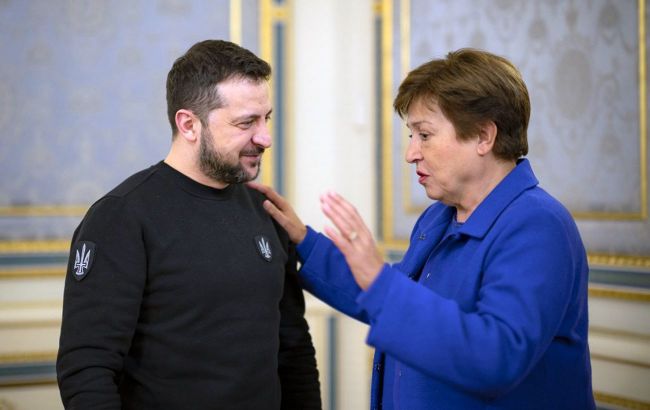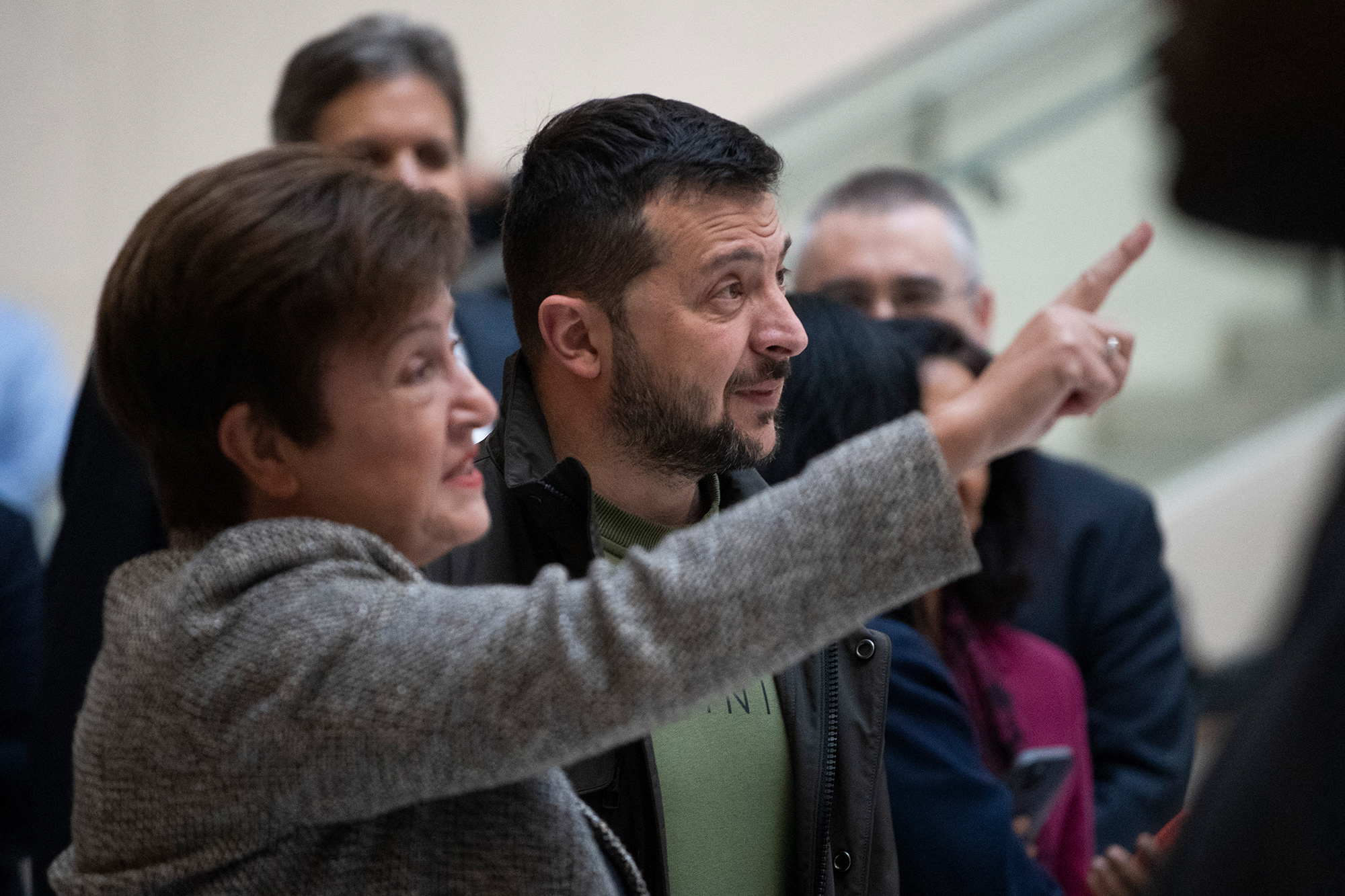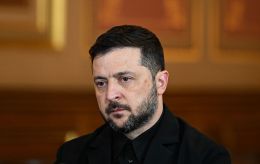Reforms pledge or debt yoke: Why IMF needs Ukraine and Ukraine needs IMF
 Volodymyr Zelenskyy and Kristalina Georgieva (photo: president.gov.ua)
Volodymyr Zelenskyy and Kristalina Georgieva (photo: president.gov.ua)
Read about the history and conditions of Ukraine's cooperation with the International Monetary Fund, reforms in exchange for money, how and why Ukraine owes the Fund so much, and why we need each other during the war in the RBC-Ukraine's review.
An International Monetary Fund mission will visit Ukraine this week to review the country's budgetary outlook and decide whether to disburse $1.1 billion more under the $15.6 billion Support and Recovery Program, Bloomberg reports.
The history of relations between Ukraine and the IMF goes back 30 years. During this time, our country has borrowed more than $45 billion from the IMF. Due to Russia's full-scale invasion of Ukraine, the Fund has agreed on a record-breaking assistance of more than $15 billion for Ukraine.
This four-year loan was the first in the Fund's history to be granted to a country at war. However, the interest rate was a record 8% per annum, compared to the standard rate of 3-4%.
Why did Ukraine agree to such terms and what are the benefits of cooperation with the International Monetary Fund for the country, read in the RBC-Ukraine article.
IMF
The International Monetary Fund was established in 1944 to help countries overcome the devastating effects of World War II. The first country to receive money from the IMF was France. The funds, that the country received in 1947, helped it rebuild its damaged infrastructure and financial sector.
Subsequently, IMF financial assistance pulled such countries as Mexico, Chile, South Korea, and Ireland out of the economic hole. And for our neighbors in Poland, cooperation with the International Monetary Fund allowed them to move from a socialist planned economy to a market economy. Thanks to the Fund, the country managed to implement the reform package of Finance Minister Leszek Balcerowicz, which went down in history as Shock Therapy.
But no less important than money is the ability to manage it. A striking example of a country that has lost the opportunity to put its economy on the newest rails is Argentina, although, at the beginning of the twentieth century, it was considered one of the most promising in the world. However, due to ineffective economic policy, the country faced a series of crises in the middle of the last century. Currently, this Latin American country is suffering from huge inflation and debt, which has made it the largest IMF debtor in the world.
History of Ukraine's cooperation with the IMF
Ukraine joined the IMF in 1992, and two years later took out its first loan under the one-year Systemic Transformation Facility (STF) program of $763 million. These funds were used to support the balance of payments.
Immediately after the end of this loan, Ukraine started a new 3-year cooperation under the Stand-by program, under which it received almost $2 billion. Since then, Ukraine has continuously extended various cooperation programs.
In total, over 30 years, Ukraine and the IMF have signed 12 loan agreements. Three of them, including the most recent one, provided for the use of the Extended Fund Facility (EFF), and nine were short-term lending arrangements (Stand-by).
Although before Russia's full-scale invasion of Ukraine, the total volume of loan programs for Ukraine amounted to $80 billion, Ukraine received less than half of this amount - about $36 billion. For example, in 2010, Ukraine agreed with the IMF on a three-year stand-by program worth $15.1 billion, but only $3.4 billion was transferred to the state treasury.
This is because each tranche of the loan depends on the fulfillment of certain conditions and reforms agreed with the IMF. In the above cases, the state did not receive the full amount due to delays in structural changes or non-compliance with the terms of the programs.
Reforms in exchange for money
Among the important reforms that the IMF pushed Ukraine to undertake is the opening of the land market, which took place in 2021. Before that, Ukraine was on a list with six, to put it mildly, not very developed countries where land sales were also banned - North Korea, Tajikistan, Congo, Venezuela, Cuba, and Belarus.
The anti-corruption reform, which, in particular, created such important institutions as the National Anti-Corruption Bureau and the Specialized Anti-Corruption Prosecutor's Office, was very important; as well as the reform of the public procurement system, which contributed to the efficiency and transparency of public resource management. The banking market was also cleaned up and the hryvnia exchange rate was abandoned.
 IMF Managing Director Kristalina Georgieva and President of Ukraine Volodymyr Zelenskyy (Photo: Getty Images)
IMF Managing Director Kristalina Georgieva and President of Ukraine Volodymyr Zelenskyy (Photo: Getty Images)
In the course of the energy reform, the government introduced market-based tariffs for gas and electricity, which helped to reduce subsidies and improve the sector's financial condition.
One of the key conditions for receiving funds under the new IMF program is the reboot of the Bureau of Economic Security (BES). The draft law on the renewal of the management and detectives of the BES was adopted on June 20 this year in a transparent competition.
How Ukraine owes so much
Ukraine is paying dearly for its reforms. As of August 23, Ukraine was the second largest debtor to the IMF after Argentina, owing the Fund $10.39 billion. The anti-leader of the list owes the IMF $31.1 billion. The bronze medalist, Egypt, owes $10.34 billion.
This situation is the result of many unfavorable events: Russia's annexation of Crimea and Russia's war in Ukraine since 2014, the coronavirus pandemic in 2020, and Russia's full-scale invasion in 2022. Since the beginning of the large-scale hostilities, Ukraine has received $10.2 billion from the IMF alone. The extraordinary events required urgent stabilization financial injections, which could primarily be provided by the IMF, which is a lender of last resort for many countries.
In general, there are no wealthy countries on the list of the IMF's largest debtors. Among the world's so-called leaders are Pakistan, Ecuador, Colombia, Kenya, Ghana, Côte d'Ivoire, Bangladesh, and Angola.
Among the European debtor leaders, developing countries were the most prominent: Serbia, Moldova, Georgia, North Macedonia, Armenia, Bosnia and Herzegovina, and Albania.
Current loan detalis
The IMF's four-year, $15.6 billion Extended Fund Facility (EFF) program is part of long-term international support for Ukraine that currently totals $122 billion.
The key goal of the program is to support fiscal, external, price, and financial stability, promote economic recovery, and strengthen institutions for long-term post-war growth on Kyiv's path to EU membership.
Although the Fund did not explicitly prohibit lending to countries at war, the IMF cannot provide funds without a clear macroeconomic forecast. And it is impossible to make one for a country where active hostilities are ongoing. That is why this agreement has become a global precedent.
“In addition to the fact that none of the international organizations had the tools to support a country at war, my conversations with many people in the West suggested that they considered it normal for a central bank to print money and have the country suffer devaluation and inflation. I disagreed with this and said that I didn't want our soldiers to think about the hryvnia exchange rate and the situation with banks instead of resisting the Russians,” Vladyslav Rashkovan, Deputy Managing Director of the International Monetary Fund for Ukraine, told Forbes Ukraine.
 IMF mission in Ukraine (photo: t.me/Denys_Smyhal)
IMF mission in Ukraine (photo: t.me/Denys_Smyhal)
It is precisely because of the high risks and uncertainty that the loan rate has reached an extremely high level. According to public statements by former National Bank of Ukraine Council member Bohdan Danylyshyn, servicing IMF loans in 2023 cost Ukraine 8% per annum. Previously, Ukraine's loan obligations were set at 3-4%.
The IMF provides support to Ukraine subject to the implementation of reforms called structural beacons. Each disbursement of funds is subject to a review of the homework done. Since the beginning of Russia's full-scale invasion, Ukraine has received the third largest amount of external financing from the IMF after the EU and the US.
As of August, four reviews of the IMF program have already taken place, bringing Ukraine about $7.6 billion. In particular, almost $900 million in March and the last tranche of $2.2 billion in July. In 2024, Ukraine expects to receive two more tranches of $1.1 billion each (in October and December).
In general, cooperation with the IMF, in addition to the obvious benefit of receiving crucial financing, is an indicator of confidence in the borrower. Therefore, Ukraine's cooperation with the International Monetary Fund should not only stabilize the economy, which suffered first from the pandemic and then from the great war but also become an additional argument for investors from around the world.

